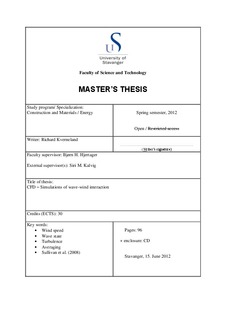| dc.description.abstract | Apart from solar energy, wind energy is the renewable energy which has the greatest potential. Offshore wind power is expected to have an annual growth of approximately 30 % in the decade to come. Even though the offshore wind industry tends to use larger turbines than over land, the standards used in designs, for the rotor-nacelle assembly, are similar to those used for onshore wind turbines. Recent studies by Kalvig et al. and Obhrai et al. (2012) reveal weaknesses in the simplifications made regarding the marine boundary layer (MBL) in the governing industry guidance and standards. Precise knowledge of wind speed is generally important for wind farm design and operations such as design basis, wind site assessment, energy yield assessment and power prediction. Wind profile and turbulence characteristics depend on the wave state, but this is usually ignored and the surface thought of as level and smooth. Field experiments and numerical simulations by Sullivan et al. (2008) and Smedman and Semedo et al. (2009) show that wave state need to be taken into account.
The goal of this study was to develop and use OpenFOAM to improve the understanding of the interactions between atmospheric wind field and surface waves. A Reynold’s averaging Navier Stokes (RANS) standard k-ε model with the capability to resolve a moving sinusoidal wave at its lower boundary was implemented. It was set up as a 2-dimensional and grid independent case. It was used as a basis for testing several boundary conditions and averaging procedures. Since a transient model is used it is important to know what to do when interpreting the results. What can one get out of snapshots, what should be averaged and how is the averaging done? Interesting patterns in the velocity profile and the turbulence characteristics were looked for in sensitivity studies where different input parameters on the wind speed and wave state were used., A comparison with the LES experiments of Sullivan et al.’s (2008) was performed in order to investigated if the wave modified wind field will be captured with the simpler CFD code?
In order to answer the questions in Kalvig’s PhD work to some extent the following research question was defined: “In which way does the sea state influence the wind field in the MBL?”
The answer to this is that surface waves impact the flow field and “footprints” are visible in the whole height of the domain. A “knee” is present as a result of speed up over the wave trough, supported by measurements from Smedman et al. (1999, 2009) and simulations from Sullivan et al. (2008). A good way of averaging was found as there is a need for averaging when studying varying wave parameters and when examining high wind speeds and rough wave states. Wind opposed with the wave propagation is decelerated close to the surface in accordance with Sullivan et al. (2008) and Smedman et al. (1999) and Kudryavtsev and Makin (2004). This implies highest vertical wind and resulting in the highest turbulent kinetic energy in an opposed situation. Although the LES experiment gives the most precise picture, the k-ɛ model used highlights many of the same features.
Using OpenFOAM requires a steep learning curve but the hard work pays off as there are no expensive licenses which other similar programs have. With the results from the sensitivity studies and comparisons with Sullivan et al. (2008) the interdependence of wave and winds, and the ability of the former to influence the flow field, are reflected. This can be used by wind park developers, professionals involved in the offshore industry, and last not least in the further PhD work of Kalvig. | no_NO |
